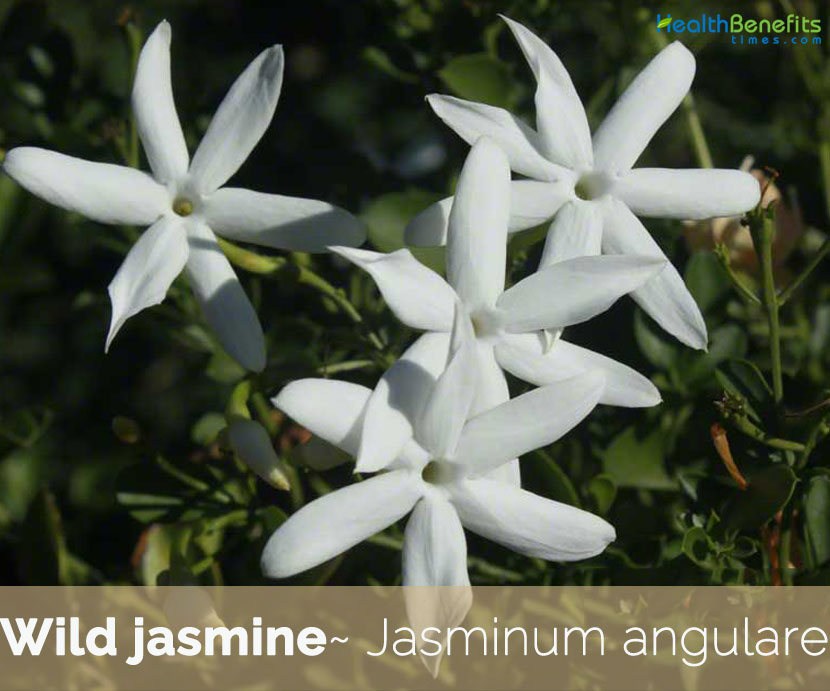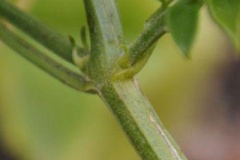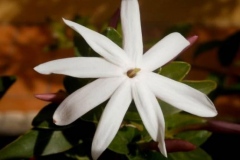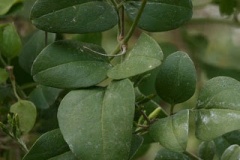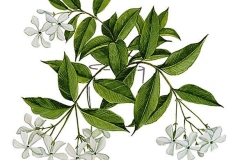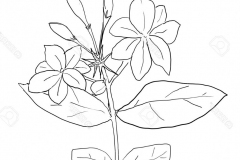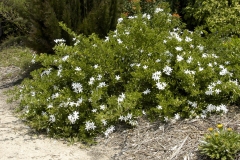| Wild jasmine Quick Facts | |
|---|---|
| Name: | Wild jasmine |
| Scientific Name: | Jasminum angulare |
| Origin | Coastal areas from Eastern Cape to Natal, South Africa |
| Colors | Green when young turning to black as they mature |
| Shapes | Decorative spherical berry, about 7 mm in diameter |
| Taste | Bitter, acrid |
| Health benefits | Beneficial for heart attacks, Immune System, Diabetes, breast and lung cancer, headaches, anxiety, Frigidity, Impotence, irritability, depression, fatigue, Stress |
| Name | Wild Jasmine |
|---|---|
| Scientific Name | Jasminum angulare |
| Native | Coastal areas from Eastern Cape to Natal, South Africa |
| Common Names | Wild Jasmine, winter jasmine, winter-flowering jasmine, angular jasmine |
| Name in Other Languages | Afrikaans: WIldejasmyn Albanian: Jasemin Arabic: يَاسَمِين Bulgarian: Ran khrishchel (ран хрищел) Catalan: Englantina Chinese: Yíng chūn huā (迎春花) Croatian: Pravi jasmin Dutch: Winterjasmijn English: Wild Jasmine, winter jasmine, winter-flowering jasmine French: Jasmin d’hiver, jasmin à fleurs nues German: Winterjasmin Hindi: Banmallika Italian: Gelsomino a fiori nudi, gelsomino d’inverno Japanese: ôbai (オウバイ) Polish: Jaśmin nagokwiatowy, jaśminek nagokwiatowy Portuguese: Jasmim-de-são-josé Russian: Zhasmin golotsvetkovyy (жасмин голоцветковый) Spanish: Jazmin, jazmin de San José, jazmín Amarillo, jazmín de invierno Swedish: Vinterjasmin Ukrainian: Zhasmin holotsvityy (жасмін голоцвітий) Zulu: Umlala |
| Plant Growth Habit | Hardy, slow growing evergreen scrambling drought-resistant shrub or vine |
| Growing Climates | Growing on trellises, walls, banks, coastal and inland bush, hillsides and near rivers |
| Soil | Performs best in well drained, fertile, loamy, well composted soil |
| Plant Size | 15-20 feet tall by 8 feet wide |
| Branches | 4–6 angled, at least in part. The branchlets and leaves may be hairless or conspicuously hairy; sometimes hairy and hairless plants occur side by side |
| Leaf | Three leaflets (3-foliate), very occasionally 5-foliate. The leaflets are variable in shape, usually broadly ovate with an acute apex |
| Flowering season | October to January |
| Flower | Pure white, strongly fragrant and produced in flat-topped, few-flowered inflorescences at the tips of the stems, from early to mid-summer. They have a long, narrow corolla tube, usually greenish on the outside, opening to a flat, white star, made up of five petal lobes |
| Fruit Shape & Size | Decorative spherical berry, about 7 mm in diameter |
| Fruit Color | Green when young turning to black as they mature |
| Propagation | Semi-ripe cuttings, layering or seed |
| Plant Parts Used | Roots, leaves |
| Available Forms | In the form of Tea or Lotion |
| Taste | Bitter, acrid |
Plant Description
Wild jasmine is a hardy, slow growing, evergreen, scrambling, drought-resistant shrub or vine. When planted on slopes and against walls it can mound 8-10 ft. tall and spread 12-15 ft. wide. When grown as a vine, it can reach 15-20 ft. tall and fit residential scale spaces very well. The plant is found growing on trellises, walls, banks, coastal and inland bush, hillsides and also near rivers. The plant performs best in well drained, fertile, loamy and well composted soil. In case of very hot summer, shade could be beneficial. The plant is used for both medicinal and magical purposes. This is quite a delicate climber that can be trained over arches and along fences and walls. It also grows well in containers.
Leaves
Leaves are made up of three leaflets (3-foliate), very occasionally 5-foliate. The leaflets are variable in shape, usually broadly ovate with an acute apex. Acarodomatia are often present on the under surface of the leaves, in the axils of lower veins.
| Leaf Arrangement | Opposite |
| Leaf Venation | Bowed |
| Leaf Persistence | Evergreen |
| Leaf Type | Bipinnately compound |
| Leaf Shape | Lanceolate |
| Leaf Margins | Entire |
| Leaf Textures | Glossy |
| Leaf Scent | No Fragrance |
| Color(growing season) | Green |
| Color(changing season) | Green |
Flowers
The flowers are pure white, strongly fragrant and produced in flat-topped, few-flowered inflorescences at the tips of the stems, from early to mid-summer. They have a long, narrow corolla tube, usually greenish on the outside, opening to a flat, white star, made up of five petal lobes, although the occasional flower has six lobes. There are two stamens that are inside the corolla tube, with the tips of the anthers to be seen in the mouth of the tube. The style is 2-lobed and the tip is exserted. The calyx, at the base of the corolla tube, is bell-shaped, green, and 7-toothed. Flowering normally takes place from October to January and attracts a whole host of tiny insects.
| Flower Showiness | True |
| Flower Type | Solitary |
| Flower Scent | Pleasant |
| Flower Color | White |
| Seasons | Summer, Fall |
Fruits
Fertile flowers are followed by a decorative spherical berry, about 7 mm in diameter. Fruits are initially green turning to black as they mature. Fruits are eaten by birds and by people in times of famine.
| Fruit Type | Berry |
| Fruit Showiness | False |
| Fruit Colors | Black |
Traditional uses and benefits of Wild Jasmine
- Jasminum angulare leaves and flowers are used in traditional medicine as a protective charm against lightning.
- It has antidepressant and aphrodisiac properties.
- Jasmine tea reduces the risk of heart attacks, strengthens immune system and prevents of Diabetes.
- It also prevents growth of cancerous cells. It reduces the risk of Breast and Lung Cancer.
- It improves the digestive system. It promotes healthy stomach. It prevents the gastrointestinal cancer.
- Wild Jasmine has calm and relaxing effect. It is used to treat headaches, anxiety, irritability and depression.
- The relaxing property of Wild Jasmine provides relief from fatigue and stress.
- Wild Jasmine treats sexual and uterine problems. Jasmine Tea is effective for sexual problems. It increases the production of Sperm. It heals Frigidity and Impotence.
- It promotes weight loss.
- It lowers the bad cholesterol level in the body.
- It eases chronic inflammation including muscle aches and pains.
- It treats sunburn, rashes, heat exhaustion and sunstroke.
- It fights off against bacterial infections.
- It is good for healing corns on foot.
- It is used to clean scrapes and cuts.
- It is also used in beauty and healthcare industries.
Other facts
- It is good used as a vine, ground cover, small shrub or espalier.
- Flowers are good in arrangements.
- Like other species of jasmine, the fragrance of the flowers is very sweet and enjoyable.
- This is quite a delicate climber that can be used over arches and along fences and walls.
- The flowers are strongly sweet-scented and can be added to pot-pourris mixtures.
Precautions
- Fresh leaves are reported to be toxic to sheep and cattle, and may cause death to the animal within 8 hours of ingestion.
- It may cause allergy.
- Avoid use if you are pregnant or breastfeeding.
- Do not consume it empty stomach. It may cause intestinal discomfort.
- Do not consume if you are allergic to caffeine.
References:
http://www.theplantlist.org/tpl/record/kew-351746
https://inlandvalleygardenplanner.org/plants/jasminum-angulare/
https://en.wikipedia.org/wiki/Jasminum_angulare
https://davesgarden.com/guides/pf/go/65654/#b
http://pza.sanbi.org/jasminum-angulare
https://gd.eppo.int/taxon/IASNU


